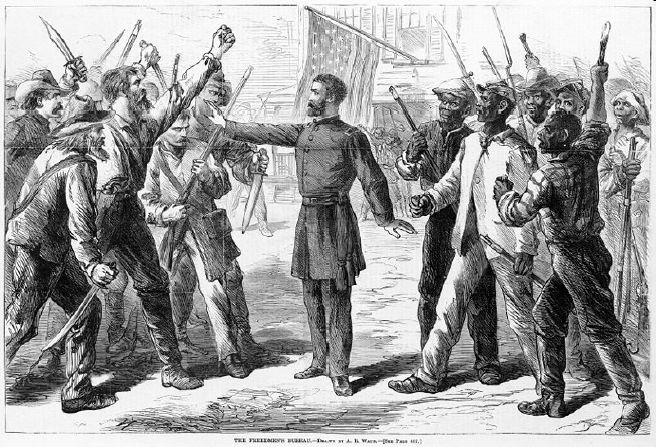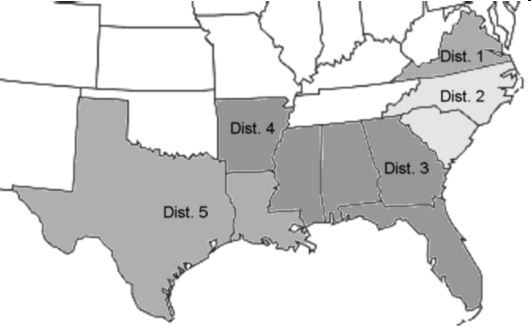Multiple Choice
Identify the
choice that best completes the statement or answers the question.
|
|
|
1.
|
What was the purpose of the Black
Codes?
a. | to give blacks the right to
vote | b. | to provide a bill of rights for
freedmen | c. | to provide a free, public education for
freedmen | d. | to restrict the actions and movement of
freedmen |
|
|
|
2.
|
Why was the 1864 Louisiana constitutional
convention reopened?
a. | to give the freedmen the right to
vote | b. | to increase the power of the office of
governor | c. | to take power away from the state lawmaking
body | d. | to address the demands of the Radical
Reconstruction |
|
|
|
3.
|
Which explains why former Confederates were unable
to vote during the time of military Reconstruction?
a. | They were in jail because of their participation in the
war. | b. | They could no longer meet the property requirement to
vote. | c. | They were no longer considered citizens of the United
States. | d. | They were unable to take an oath that they had been
loyal to the Union. |
|
|
|
4.
|
What was the purpose of the Returning
Board?
a. | It returned rights to former
slaves. | b. | It approved the qualifications of political
candidates. | c. | It checked the
results of the 1868 presidential election. | d. | It helped former
Confederates adjust to a non-military life. |
|
|
|
5.
|
Which statement best characterizes the goals
of the Southern Democratic Party following the Civil War?
a. | A focused effort to provide equality for women and free
blacks. | b. | A commitment to white supremacy and segregation between
the races. | c. | A commitment to
help freedmen find success as they acclimated to their new life. | d. | A concerted effort to reenter the United States and take responsibility for
their actions. |
|
|
|
Use the event list to answer the next question(s). 
|
|
|
6.
|
Which event occurred in 1865?
a. | Civil War began | b. | Colfax Massacre | c. | Black Codes
passed | d. | 15th Amendment
ratified |
|
|
|
7.
|
Which event occurred in 1873?
a. | Civil War ended | b. | Colfax Massacre | c. | Black Codes
passed | d. | 13th Amendment
ratified |
|
|
|
8.
|
Based on the timeline, which best characterizes
Louisiana’s Reconstruction period?
a. | safety and change | b. | peace and stability | c. | change and
violence | d. | prosperous and
peaceful |
|
|
|
9.
|
Which event marks the end of the Reconstruction
period?
a. | end of segregation | b. | passing of Black Codes | c. | federal troops
withdrawn | d. | ratifying the 15th
Amendment |
|
|
|
10.
|
Which event created a need to pass the 14th
Amendment?
a. | Colfax Massacre | b. | ending segregation | c. | passing Black
Codes | d. | attack on the
Cabildo |
|
|
|
11.
|
Which resulted from Louisiana’s early
military occupation during the Reconstruction period?
a. | Citizens were forced to keep soldiers in their
homes. | b. | Louisiana was the first state to be accepted back into
the United States. | c. | Louisiana’s
Reconstruction was easier and safer because of the military presence. | d. | Louisiana was used as a testing ground for policies designed to bring rebel
states back into the nation. |
|
|
|
Read the passage and then answer the question(s). 
|
|
|
12.
|
What legislation is this passage referring
to?
a. | Radical Reconstruction | b. | Military Reconstruction | c. | Lincoln’s
Ten Percent Plan | d. | Johnson’s
Ten Percent Plan |
|
|
|
13.
|
Who opposed the plan described in the
passage?
a. | Andrew Johnson | b. | Abraham Lincoln | c. | Radical
Republicans | d. | Southern
Democrats |
|
|
|
14.
|
What evidence supports Congress’ feelings
towards Lincoln’s 1863 Reconstruction plan?
a. | They quickly agreed and passed supporting legislation in
both houses of Congress. | b. | They welcomed
former Confederate generals back to congressional sessions. | c. | They refused to recognize or seat the new delegation from reconstructed
Louisiana. | d. | They overturned
his Ten Percent Plan and forged ahead with their own radical
reconstruction. |
|
|
|
15.
|
 Which conclusion can be
drawn from the cartoon? Which conclusion can be
drawn from the cartoon?a. | Freedmen did not want the support of the
Freedmen’s Bureau. | b. | Former
Confederates supported the work of the Freedmen’s Bureau. | c. | The purpose of the Freedmen’s Bureau was to protect the newly freed
slaves. | d. | The Freedmen’s Bureau put an end to conflicts
between whites and former slaves. |
|
|
|
16.
|
What did the federal government do in response to
the South’s dealings with newly freed slaves?
a. | passed Black Codes | b. | passed the 13th Amendment | c. | implemented the Ten Percent Plan | d. | established the Freedmen’s Bureau |
|
|
|
17.
|
How did Northerners respond to the passage of Black
Codes in Southern states?
a. | They did not care since they did not live in the
South. | b. | They disagreed with them but did not want to get
involved. | c. | They applauded Southern efforts to control the large
populations of freedmen. | d. | They saw them as
an extension of slavery and called for firmer federal
legislation. |
|
|
|
18.
|
Why did Republicans gather in the Mechanics’
Institute building on July 30, 1866?
a. | to discuss campaign strategy | b. | to discuss freedmen’s right to vote | c. | to develop a new system for counting votes | d. | to outline talking points for the next
campaign |
|
|
|
19.
|
What started the riot at the Mechanics’
Institute?
a. | a punch | b. | a gun shot | c. | name
calling | d. | rock throwing |
|
|
|
20.
|
Which happened as a result of the 1866
Mechanics’ Institute Riot?
a. | President Johnson sent troops to Louisiana to prevent
another riot. | b. | Former
Confederates who had participated in the riot were tried and jailed. | c. | Laws were immediately passed giving freedmen the right to vote in
Louisiana. | d. | Northern outrage
led to the election of more Radical Republicans and stricter
legislation. |
|
|
|
21.
|
What is another name for the time period when the
South was subject to the Reconstruction Acts?
a. | Active Reconstruction | b. | Radical Reconstruction | c. | Military
Reconstruction | d. | Democratic
Reconstruction |
|
|
|
Use the map to answer the question(s).
Southeastern United States, 1868

|
|
|
22.
|
What is shown in the map?
a. | All of the Southern states that seceded from the
Union. | b. | The five military districts created by the
Reconstruction Acts. | c. | The order in which
rebel states were readmitted to the Union. | d. | A ranking of the
population density of freedmen in the Southern states. |
|
|
|
23.
|
In which military district was Louisiana placed
under the Reconstruction Acts?
a. | District 1 | b. | District 2 | c. | District
4 | d. | District 5 |
|
|
|
24.
|
During Military Reconstruction, what requirements
had to be met before a state could adopt a new constitution and elect a new state
government?
a. | affirm the U.S. Constitution and Bill of
Rights | b. | swear an oath of loyalty to the United
States | c. | register former male slaves and free men of color to
vote | d. | ratify the 14th Amendment and register former male
slaves and free men of color to vote |
|
|
|
25.
|
Which abolished Black Codes in
Louisiana?
a. | 13th Amendment | b. | Democratic Platform | c. | Constitution of
1868 | d. | Reconstruction
Acts |
|
|
|
Constitution of
1864 | Constitution of 1868 | Abolished slavery | Extended civil rights to former slaves | Voting rights
for black men who served in the Union , owned property, and were literate were
authorized. | Extended
voting rights to black males | Free public school system for children
6-18. | Removed property qualifications
for voting | | | Abolished Black Codes | | | Racially integrated public school system statewide | | | Equal treatment on public transportation and at public businesses for all
people | | | Removed voting rights from former
Confederates | | |
|
|
|
26.
|
How was the Constitution of 1868 different from the
Constitution of 1864?
a. | It was more equalitarian. | b. | It established white supremacy. | c. | It allowed former Confederates to vote. | d. | It included provisions for public
schooling. |
|
|
|
27.
|
Which conclusion can be drawn about the
Constitution of 1868?
a. | The 1868 Constitution reflected the ideology of
Louisiana’s Democratic party. | b. | The
Freedmen’s Bureau forced Louisiana’s legislature to adopt the Constitution of
1868. | c. | The 1868 Constitution was written by Democrats seeking
African American support for the party. | d. | The 1868
Constitution was written by Republicans seeking African American support for the
party. |
|
|
|
28.
|
Which of the following is the meaning of
disfranchise?
a. | allow a person to vote | b. | to deny a person citizenship | c. | fine a person for tax evasion | d. | to take away the right to vote |
|
|
|
29.
|
Which describes the group that native Louisiana
critics referred to as carpetbaggers?
a. | Freedmen’s Bureau employees who came to help
former slaves. | b. | Free blacks who
moved to the South to help former slaves adjust to their freedom. | c. | Northerners who traveled to the South during Reconstruction in search of
opportunity. | d. | Republicans who
worked to extend voting rights to former slaves and free
blacks. |
|
|
|
30.
|
Which explains why many Louisiana elections were
disputed in the late 1800s?
a. | voter fraud and intimidation | b. | corruption and illiterate voters | c. | voter fraud and illiterate voters | d. | illiterate voters and intimidation |
|